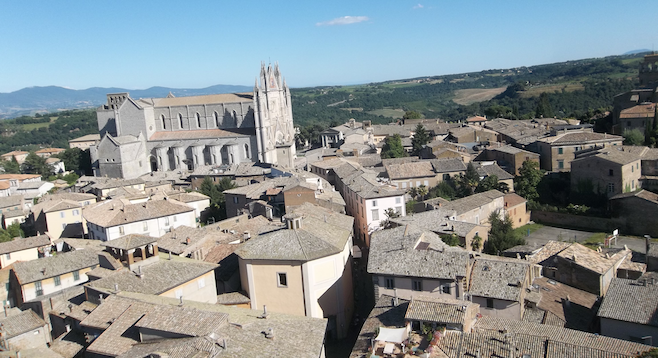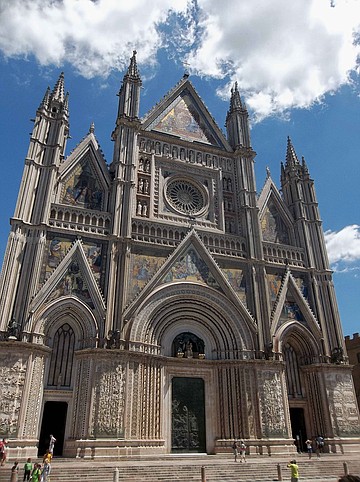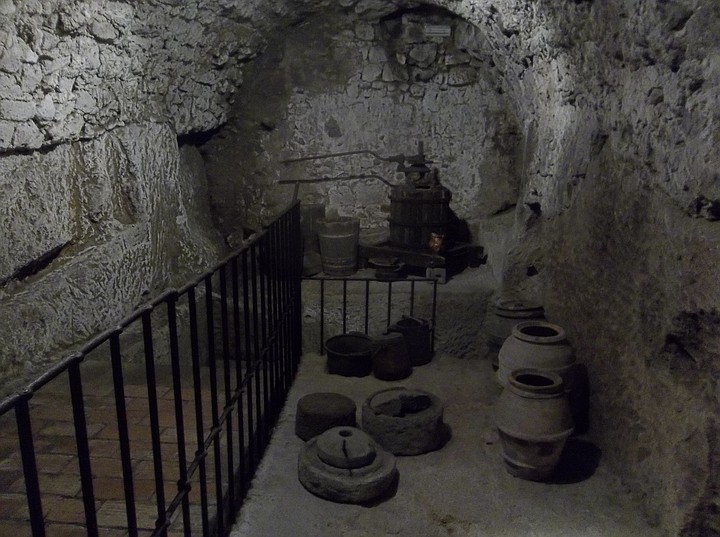 Facebook
Facebook
 X
X
 Instagram
Instagram
 TikTok
TikTok
 Youtube
Youtube

For hundreds of years, Orvieto was a major stopping point along the road from Florence to Rome. It was so highly regarded through the centuries that it is only one of two cities outside of Rome to house papal residences. This classic hill town is still an essential destination on a visit to Umbria – where you can bask in a leisurely atmosphere while enjoying a spectacular cathedral, Classico white wine, and underground chambers dating from the Etruscan era.
Upon arrival, it’s advisable that you bypass the lower, modern town and take the funicular up the hill from the train station to the enchanting old town. At the summit, built upon mounds of tufa stone a thousand feet above the valley, pause along the edge of the cliffs to admire the striking view of the surrounding countryside. From there you can board a shuttle to Orvieto’s main square, Piazza del Duomo, adjacent to Orvieto’s eye-catching cathedral, the town’s most famous landmark.
I reserved a bed and breakfast just near the Piazza del Duomo, which made my arrival quite uncomplicated. I just rolled my bag a block down cobblestoned Via del Duomo into town. You can also be picked up at Piazza del Duomo for a return trip to the funicular. It beats paying for a taxi!

The cathedral, or Duomo, in the Piazza del Duomo may have the most stunning façade of any church in Italy. Dating from the 13th and 14th centuries, the Romanesque-Gothic cathedral inspires awe with its exterior of mosaics, stained glass, sculptures and medieval bas-reliefs. Panels on the marble walls depict stories from the Bible. In the Chapel of San Brizio in the interior of the Duomo, view frescos of the Day of Judgment by Luca Signorelli. These were a major inspiration for Michelangelo’s Last Judgment in the Sistine Chapel. Michelangelo also studied Signorelli’s work for its pioneering depiction of anatomically accurate nudes. (Signorelli spent years on the work while being provided with the finest of Umbrian white wine to see him through the project.)

The top of the hill is flat, which makes the town quite walkable. This is an excellent way to explore the layers of history here. Quite literally, layers. Orvieto was once a major center of the Etruscan civilization that predated the Romans. There are several tours inviting you to explore the labyrinths of underground caves, tunnels and wells below the town’s surface. These passageways were originally constructed by the Etruscans to obtain water and hold off the Roman occupation. Underground Orvieto Tours is the most popular tour, although Well of the Cave, discovered by a local family while renovating their trattoria, and St. Patrick’s Well are worthwhile visits also. There are as many as 1,200 caves under the town’s surface constructed during various eras of Orvieto’s history!

Orvieto has a tradition dating to ancient times of producing creative and varied ceramics. Several shops around town display these colorful objects, which reveal an impressive creativity by local artists. A medieval kiln in the center of town was recently discovered, and several pieces are exhibited at ceramicunderground.org. There are also two museums near the cathedral that display Etruscan pottery, dishes, and other artifacts.
Underscoring its significance as a center of culture, Orvieto is home to several festivals throughout the year, including the Umbria Jazz Festival and the Umbria Folk festival.
Orvieto is geared to pedestrians; there isn’t a single traffic light in the town. One drawback to walking the narrow cobblestoned streets is dodging the few cars that wind – at times a bit too impatiently – through the narrow passageways where tourists and locals are wandering. But this just encourages the opportunity to get off the main streets to explore the non-touristy areas.
To truly appreciate the town's unusual setting, wind back down the hill and take a walk on the Rupe. This pedestrian path encircles the walled hilltop town beneath the towering cliffs of tufa stone on which the town is constructed.
After exploring Orvieto by foot, I climbed up a few hundred steps to the top of the clock tower for a panoramic late-afternoon overview of the town: a clear view of the Umbrian hills in the near distance, with the town below that has probably changed little in the past several hundred years.
There's no lack of outdoor cafes and restaurants in Orvieto. The square adjoining the cathedral is ringed with cafes and a popular gelateria. Take a break from strolling and embrace the opportunity to relax in the leisurely, timeless atmosphere the town provides. Early evening is a particularly tranquil time for a café stop, as most of the tourists have moved on by then. Young locals hang out in the square by the cathedral listening to music and fraternizing.
Orvieto can be enjoyed on a day trip from Rome, as it is only about an hour’s drive north. But if you have an extra day, it’s recommended that you make a visit to a nearby charming, automobile-free hill town called Civita de Bagnoreggio. Compared to Civita, Orvieto is a booming metropolis.
This tiny hill town that one can walk across in about five minutes sits on a plateau overlooking the Tiber Valley. In medieval days, 4,000 people lived here, but there are now less than twenty permanent residents and just a handful of restaurants and lodging opportunities. Most visitors, however, find Civita one of the most pleasant and memorable hill towns in Italy. A footbridge leads the way to town about a mile up the hill from the bus stop. For hundreds of years residents used donkeys to transport items to town on an older bridge.
Buses leave frequently from Orvieto for the 45-minute trip past vineyards and olive groves to Civita. Though many Italians I met had never even heard of Civita, those who were familiar with it could hardly contain their enthusiasm.
“That’s a great place,” a Tuscan friend of mine remarked when I asked him about the town, his eyes gleaming at the memory of his visit.


For hundreds of years, Orvieto was a major stopping point along the road from Florence to Rome. It was so highly regarded through the centuries that it is only one of two cities outside of Rome to house papal residences. This classic hill town is still an essential destination on a visit to Umbria – where you can bask in a leisurely atmosphere while enjoying a spectacular cathedral, Classico white wine, and underground chambers dating from the Etruscan era.
Upon arrival, it’s advisable that you bypass the lower, modern town and take the funicular up the hill from the train station to the enchanting old town. At the summit, built upon mounds of tufa stone a thousand feet above the valley, pause along the edge of the cliffs to admire the striking view of the surrounding countryside. From there you can board a shuttle to Orvieto’s main square, Piazza del Duomo, adjacent to Orvieto’s eye-catching cathedral, the town’s most famous landmark.
I reserved a bed and breakfast just near the Piazza del Duomo, which made my arrival quite uncomplicated. I just rolled my bag a block down cobblestoned Via del Duomo into town. You can also be picked up at Piazza del Duomo for a return trip to the funicular. It beats paying for a taxi!

The cathedral, or Duomo, in the Piazza del Duomo may have the most stunning façade of any church in Italy. Dating from the 13th and 14th centuries, the Romanesque-Gothic cathedral inspires awe with its exterior of mosaics, stained glass, sculptures and medieval bas-reliefs. Panels on the marble walls depict stories from the Bible. In the Chapel of San Brizio in the interior of the Duomo, view frescos of the Day of Judgment by Luca Signorelli. These were a major inspiration for Michelangelo’s Last Judgment in the Sistine Chapel. Michelangelo also studied Signorelli’s work for its pioneering depiction of anatomically accurate nudes. (Signorelli spent years on the work while being provided with the finest of Umbrian white wine to see him through the project.)

The top of the hill is flat, which makes the town quite walkable. This is an excellent way to explore the layers of history here. Quite literally, layers. Orvieto was once a major center of the Etruscan civilization that predated the Romans. There are several tours inviting you to explore the labyrinths of underground caves, tunnels and wells below the town’s surface. These passageways were originally constructed by the Etruscans to obtain water and hold off the Roman occupation. Underground Orvieto Tours is the most popular tour, although Well of the Cave, discovered by a local family while renovating their trattoria, and St. Patrick’s Well are worthwhile visits also. There are as many as 1,200 caves under the town’s surface constructed during various eras of Orvieto’s history!

Orvieto has a tradition dating to ancient times of producing creative and varied ceramics. Several shops around town display these colorful objects, which reveal an impressive creativity by local artists. A medieval kiln in the center of town was recently discovered, and several pieces are exhibited at ceramicunderground.org. There are also two museums near the cathedral that display Etruscan pottery, dishes, and other artifacts.
Underscoring its significance as a center of culture, Orvieto is home to several festivals throughout the year, including the Umbria Jazz Festival and the Umbria Folk festival.
Orvieto is geared to pedestrians; there isn’t a single traffic light in the town. One drawback to walking the narrow cobblestoned streets is dodging the few cars that wind – at times a bit too impatiently – through the narrow passageways where tourists and locals are wandering. But this just encourages the opportunity to get off the main streets to explore the non-touristy areas.
To truly appreciate the town's unusual setting, wind back down the hill and take a walk on the Rupe. This pedestrian path encircles the walled hilltop town beneath the towering cliffs of tufa stone on which the town is constructed.
After exploring Orvieto by foot, I climbed up a few hundred steps to the top of the clock tower for a panoramic late-afternoon overview of the town: a clear view of the Umbrian hills in the near distance, with the town below that has probably changed little in the past several hundred years.
There's no lack of outdoor cafes and restaurants in Orvieto. The square adjoining the cathedral is ringed with cafes and a popular gelateria. Take a break from strolling and embrace the opportunity to relax in the leisurely, timeless atmosphere the town provides. Early evening is a particularly tranquil time for a café stop, as most of the tourists have moved on by then. Young locals hang out in the square by the cathedral listening to music and fraternizing.
Orvieto can be enjoyed on a day trip from Rome, as it is only about an hour’s drive north. But if you have an extra day, it’s recommended that you make a visit to a nearby charming, automobile-free hill town called Civita de Bagnoreggio. Compared to Civita, Orvieto is a booming metropolis.
This tiny hill town that one can walk across in about five minutes sits on a plateau overlooking the Tiber Valley. In medieval days, 4,000 people lived here, but there are now less than twenty permanent residents and just a handful of restaurants and lodging opportunities. Most visitors, however, find Civita one of the most pleasant and memorable hill towns in Italy. A footbridge leads the way to town about a mile up the hill from the bus stop. For hundreds of years residents used donkeys to transport items to town on an older bridge.
Buses leave frequently from Orvieto for the 45-minute trip past vineyards and olive groves to Civita. Though many Italians I met had never even heard of Civita, those who were familiar with it could hardly contain their enthusiasm.
“That’s a great place,” a Tuscan friend of mine remarked when I asked him about the town, his eyes gleaming at the memory of his visit.
Comments